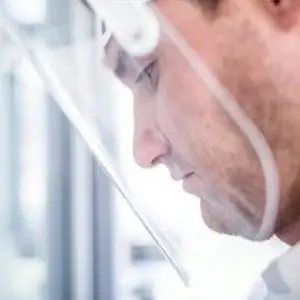If you work in a laboratory, you know that face shields are a vital part of your personal protective equipment. But what exactly do they protect you from? Well, essentially, laboratory face shields protect you from exposure to dangerous chemicals. By creating a barrier between your face and the chemicals, the shield helps to keep you safe.
What are laboratory face shields?
Laboratory face shields are clear plastic shields that cover the entire front of the face and provide full-face coverage. They are used in laboratories to protect the wearer’s face from chemicals and other potential hazards. Face shields are an important part of personal protective equipment (PPE) for workers in many industries, including healthcare, manufacturing, and research.
What are the benefits of using a face shield?
Some benefits of using a face shield include:
- They protect your face from harmful UV rays.
- They provide a barrier against splash and splatter.
- They help to protect your respiratory system by trapping droplets and particles before they can enter your nose or mouth.
- They can be easily disinfected, making them more hygienic than cloth masks.
OSHA recommends the use of face shields when workers are exposed to physical or chemical hazards. Face shields provide barrier protection against splash and splatter, UV rays, and airborne debris. Face shields are commonly used in healthcare, dental, and construction settings.
What chemicals do laboratory face shields protect against?
Different chemicals require different levels of protection. Face shields provide barrier protection against splash and splatter of body fluids. They also protect against large droplets (e.g., large-particle droplets [> 100 microns] that are generated when an individual coughs or sneezes), and thus can also serve as source control.
Face shields are not designed to protect the wearer’s face from airborne particles, such as those generated during procedures using grinding, sawing, or sandblasting (i.e., procedures that generate small [< 100 microns] particles).
But no matter which type of chemical you’re dealing with, one thing is for sure: a laboratory face shield is an essential piece of safety equipment. When choosing a face shield, it’s important to select one that is appropriate for the particular substance you’ll be working with.
How effective are laboratory face shields?
There is no single answer to this question as the level of protection offered by a face shield depends on a number of factors, including the type of shield, the type of chemicals you are working with, and the way in which you are using the shield.
In general, however, face shields provide a good deal of protection against chemicals, particularly when used in combination with other safety equipment such as gloves and protective clothing. They are most effective when used correctly and consistently, so it is important to follow the manufacturer’s instructions for use.
Are there any drawbacks to using a face shield?
While face shields offer much more protection than face masks alone, they are not without drawbacks. For one, they can fog up more easily than masks, which can be a problem if you need to wear them for long periods of time.
Additionally, they can be hot and uncomfortable to wear for extended periods, and some people find them difficult to breathe in. Finally, it is important to remember that face shields alone will not protect you from COVID-19; you must also practice social distancing and good hand hygiene.
How should laboratory face shields be used?
In general, face shields are worn in combination with other personal protective equipment (PPE) such as gloves, gowns, and masks. It is important to select face shields that fit comfortably over the top of prescription eyewear or safety goggles. The shield should extend below the chin and be wide enough to cover the entire side of the face.
Face shields protect mucous membranes of the eyes, nose, and mouth from contact with blood and other body fluids as well as from contact with infectious materials such as splash and droplets. Shields should be selected based on the type of activity being performed and the anticipated level of exposure.
How often should laboratory face shields be replaced?
There are no specific requirements for how often laboratory face shields should be replaced. However, it is generally recommended that they be replaced whenever they become visibly dirty or damaged, or if the user feels that they no longer provide adequate protection.
Where can I find more information on laboratory face shields?
There are many manufacturers of laboratory face shields, and each provides its own product information. The Centers for Disease Control and Prevention (CDC) does not have any specific recommendations for face shields but recommends that personal protective equipment (PPE) be used as needed to protect against chemical exposure.
In Closing
Laboratory face shields are an integral piece of PPE that lab workers wear to protect themselves from harmful chemicals while working.
NEXT UP: Tactical Face Shields – Key Features


